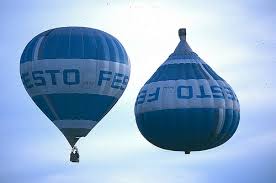Think of a hot air balloon, and the first image that springs to mind is likely to be the iconic ‘bulb’ shaped envelope, just like our Bailey Balloon and Red Letter Days hot air balloon. Balloons are traditionally made this way because this is the most efficient shape to hold heated air, with the largest air volume at the top of the envelope, tapering down in size towards the balloon basket.

Traditional Shape Hot Air Balloon
However, balloon envelopes are not confined to this traditional shape – ‘special-shaped’ balloons make a truly dramatic visual impact in the skies, and can be made into almost any shape imaginable. Some of our favourites here in the office include the Caramel Bunny Balloon, The Orient Express and the Flying Cow balloon!
Rupert the Bear Balloon photo credit pinterest.comThe Rupert the Bear balloon is the favourite of Bailey Balloons Chief Pilot, Clive Bailey. When cold inflating the envelope, the 190ft high Rupert appears to wave at onlookers as he begins to inflate.
Perhaps one of the most dramatic takes on a special shape is the Festo “upside down balloon”. Manufactured by Cameron Balloons, the balloon appears to be standing on its head!

Festo Upside Down Balloon
The process of producing a show-stopping special shape balloon is extremely complex – it begins with creating an illustration and then a blueprint, followed by the generation of a 3D computer model. Fabric panels are then stitched together, before the final structural elements are added. Cameron Balloons, based in Bristol, are world leaders in production of special shapes, and have produced over a thousand different shaped balloons. One of their most popular recent special shapes is the Stuart the Minion Balloon, which you might have seen flying from the Bristol Balloon Fiesta in August. The Cameron Balloons website has a great web page explaining all about the making of Stuart:
http://www.cameronballoons.co.uk/inflatable-me
Stuart the minion balloonFlying a special shape balloon entails different challenges in comparison to flying a traditional shaped one; depending on the exact shape of the balloon there are various restrictions in terms of maximum wind speeds, and also ascent and descent rates – rapid pressure changes in narrow sections of the envelope could cause damage, so the pilot must very carefully take this into account when flying. It is also more of a challenge to land a special shape balloon, and due to the large amount of material involved in the making of the envelope, they are very heavy and difficult to pack away, taking more pairs of hands compared to a normal shaped balloon of similar size!
The possibilities of a special shape balloon are endless, but it’s hard to beat the iconic silhouette of the traditional hot air balloon.